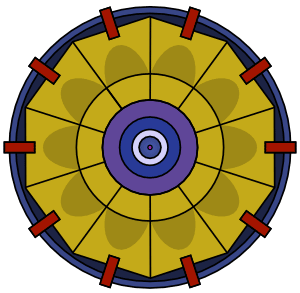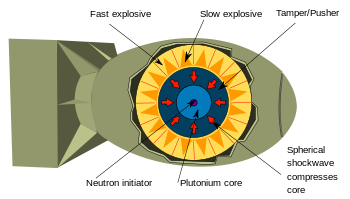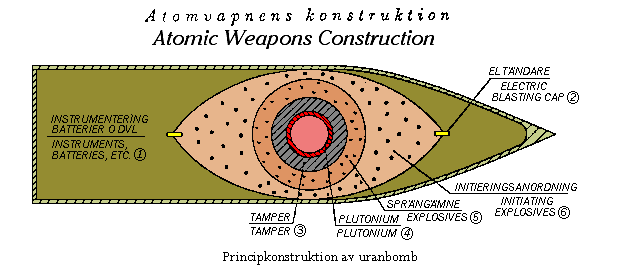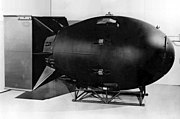Pure fission weapons
The first task of a nuclear weapon design is to rapidly assemble, at the time of detonation, more than one
critical mass of fissile uranium or plutonium. A critical mass is one in which the percentage of fission-produced neutrons which are captured and cause more fission is large enough to perpetuate the fission and prevent it from dying out.
Once the critical mass is assembled, at maximum density, a burst of neutrons is supplied to start as many chain reactions as possible. Early weapons used an "urchin" inside the pit containing non-touching interior surfaces of
polonium-210 and
beryllium. Implosion of the pit crushed the urchin, bringing the two metals in contact to produce free neutrons. In modern weapons, the neutron generator is a high-voltage vacuum tube containing a
particle accelerator which bombards a deuterium/tritium-metal hydride target with deuterium and tritium
ions. The resulting
small-scale fusion produces neutrons at a protected location outside the physics package, from which they penetrate the pit. This method allows better control of the timing of chain reaction initiation.
The critical mass of an uncompressed sphere of bare metal is 110 lb (50 kg) for uranium-235 and 35 lb (16 kg) for delta-phase plutonium-239. In practical applications, the amount of material required for critical mass is modified by shape, purity, density, and the proximity to
neutron-reflecting material, all of which affect the escape or capture of neutrons.
To avoid a chain reaction during handling, the fissile material in the weapon must be sub-critical before detonation. It may consist of one or more components containing less than one uncompressed critical mass each. A thin hollow shell can have more than the bare-sphere critical mass, as can a cylinder, which can be arbitrarily long without ever reaching critical mass.
A
tamper is an optional layer of dense material surrounding the fissile material. Due to its
inertia it delays the expansion of the reacting material, increasing the efficiency of the weapon. Often the same layer serves both as tamper and as neutron reflector.
Gun-type assembly weapon

Diagram of a gun-type fission weapon
Little Boy, the Hiroshima bomb, used 141 lb (64 kg) of uranium with an average enrichment of around 80%, or 112 lb (51 kg) of U-235, just about the bare-metal critical mass. (See
Little Boy article for a detailed drawing.) When assembled inside its tamper/reflector of tungsten carbide, the 141 lb (64 kg) was more than twice critical mass. Before the detonation, the uranium-235 was formed into two sub-critical pieces, one of which was later fired down a gun barrel to join the other, starting the atomic explosion. About 1% of the uranium underwent fission;
[8] the remainder, representing most of the entire wartime output of the giant factories at Oak Ridge, scattered uselessly.
[9]The inefficiency was caused by the speed with which the uncompressed fissioning uranium expanded and became sub-critical by virtue of decreased density. Despite its inefficiency, this design, because of its shape, was adapted for use in small-diameter, cylindrical artillery shells (a
gun-type warhead fired from the barrel of a much larger gun). Such warheads were deployed by the U.S. until 1992, accounting for a significant fraction of the U-235 in the arsenal, and were some of the first weapons dismantled to comply with treaties limiting warhead numbers.
Implosion type weapon
Fat Man, the Nagasaki bomb, used 13.6 lb (6.2 kg, about 12 fluid ounces in volume) of Pu-239, which is only 39% of bare-metal critical mass. (See
Fat Man article for a detailed drawing.) The U-238 reflected, 13.6 lb (6.2 kg) pit was sub-critical before detonation. During detonation, criticality was achieved by implosion. The plutonium pit was squeezed to increase its density by simultaneous detonation of conventional explosives placed uniformly around the pit. The explosives were detonated by multiple
exploding-bridgewire detonators. It is estimated that only about 20% of the plutonium underwent fission, the rest (about 11 lb (5.0 kg) or 5 kg) was scattered.

An implosion shock wave might be of such short duration that only a fraction of the pit is compressed at any instant as the wave passes through it. A pusher shell made out of low
density metal—such as
aluminium,
beryllium, or an
alloy of the two metals (aluminium being easier and safer to shape and beryllium for its high-neutron-reflective capability) —may be needed. The pusher is located between the explosive lens and the tamper. It works by reflecting some of the shock wave backwards, thereby having the effect of lengthening its duration. Fat Man used an aluminium pusher.
The key to Fat Man's greater efficiency was the inward momentum of the massive U-238 tamper (which did not undergo fission). Once the chain reaction started in the plutonium, the momentum of the implosion had to be reversed before expansion could stop the fission. By holding everything together for a few hundred nanoseconds more, the efficiency was increased.
Plutonium pit
The core of an implosion weapon – the fissile material and any reflector or tamper bonded to it – is known as the
pit. Some weapons tested during the 1950s used pits made with U-235 alone, or in composite with
plutonium,
[10] but all-plutonium pits are the smallest in diameter and have been the standard since the early 1960s.
Casting and then machining plutonium is difficult not only because of its toxicity, but also because plutonium has many different
metallic phases, also known as
allotropes. As plutonium cools, changes in phase result in distortion. This distortion is normally overcome by alloying it with 3–3.5 molar% (0.9–1.0% by weight)
gallium which causes it to take up its delta phase over a wide temperature range.
[11] When cooling from molten it then suffers only a single phase change, from epsilon to delta, instead of the four changes it would otherwise pass through. Other
trivalent metals would also work, but gallium has a small neutron
absorption cross section and helps protect the plutonium against
corrosion. A drawback is that gallium compounds themselves are corrosive and so if the plutonium is recovered from dismantled weapons for conversion to
plutonium dioxide for
power reactors, there is the difficulty of removing the gallium.
Because plutonium is chemically reactive and toxic if it enters the body by inhalation or any other means, for protection of the assembler, it is common to plate the completed pit with a thin layer of inert metal. In the first weapons,
nickel was used but
gold is now preferred.
[12]Levitated-pit implosion
The first improvement on the Fat Man design was to put an air space between the tamper and the pit to create a hammer-on-nail impact. The pit, supported on a hollow cone inside the tamper cavity, was said to be levitated. The three tests of
Operation Sandstone, in 1948, used Fat Man designs with levitated pits. The largest yield was 49 kilotons, more than twice the yield of the unlevitated Fat Man.
[13]It was immediately clear that implosion was the best design for a fission weapon. Its only drawback seemed to be its diameter. Fat Man was 5 feet (1.5 m) wide vs 2 feet (60 cm)for Little Boy.
Eleven years later, implosion designs had advanced sufficiently that the 5 foot-diameter sphere of Fat Man had been reduced to a 1 foot-diameter (30 cm) cylinder 2 feet (60 cm) long, the Swan device.
The Pu-239 pit of Fat Man was only 3.6 inches (9 cm) in diameter, the size of a softball. The bulk of Fat Man's girth was the implosion mechanism, namely concentric layers of U-238, aluminium, and high explosives. The key to reducing that girth was the two-point implosion design.
Two-point linear implosion
A very inefficient implosion design is one that simply reshapes an ovoid into a sphere, with minimal compression. In linear implosion, an untamped, solid, elongated mass of Pu-239, larger than critical mass in a sphere, is imbedded inside a cylinder of high explosive with a detonator at each end.
[14]Detonation makes the pit critical by driving the ends inward, creating a spherical shape. The shock may also change plutonium from delta to alpha phase, increasing its density by 23%, but without the inward momentum of a true implosion. The lack of compression makes it inefficient, but the simplicity and small diameter make it suitable for use in artillery shells and atomic demolition munitions - ADMs - also known as backpack or
suitcase nukes.
All such low-yield battlefield weapons, whether gun-type U-235 designs or linear implosion Pu-239 designs, pay a high price in fissile material in order to achieve diameters between six and ten inches (254 mm) .
Two-point hollow-pit implosion
A more efficient two-point implosion system uses two high explosive lenses and a hollow pit.
A hollow plutonium pit was the original plan for the 1945 Fat Man bomb, but there was not enough time to develop and test the implosion system for it. A simpler solid-pit design was considered more reliable, given the time restraint, but it required a heavy U-238 tamper, a thick aluminum pusher, and three tons of high explosives.
After the war, interest in the hollow pit design was revived. Its obvious advantage is that a hollow shell of plutonium, shock-deformed and driven inward toward its empty center, would carry momentum into its violent assembly as a solid sphere. It would be self-tamping, requiring a smaller U-238 tamper, no aluminum pusher, and less high explosive. The hollow pit made levitation obsolete.
The Fat Man bomb had two concentric, spherical shells of high explosives, each about 10 inches (25 cm) thick. The inner shell drove the implosion. The outer shell consisted of a
soccer-ball pattern of 32 high explosive lenses, each of which converted the convex wave from its detonator into a concave wave matching the contour of the outer surface of the inner shell. If these 32 lenses could be replaced with only two, the high explosive sphere could become an ellipsoid (prolate spheroid) with a much smaller diameter.
A good illustration of these two features is a 1956 drawing from the
Swedish nuclear weapon program (which was terminated before it produced a test explosion). The drawing shows the essential elements of the two-point hollow-pit design.
There are similar drawings in the open literature that come from the post-war German nuclear bomb program, which was also terminated, and from the French program, which produced an arsenal.
The mechanism of the high explosive lens (diagram item #6) is not shown in the Swedish drawing, but a standard lens made of fast and slow high explosives, as in Fat Man, would be much longer than the shape depicted. For a single high explosive lens to generate a concave wave that envelops an entire hemisphere, it must either be very long or the part of the wave on a direct line from the detonator to the pit must be slowed dramatically.
A slow high explosive is too fast, but the flying plate of an "air lens" is not. A metal plate, shock-deformed, and pushed across an empty space can be designed to move slowly enough.
[15][16] A two-point implosion system using air lens technology can have a length no more than twice its diameter, as in the Swedish diagram above.
References
Specific
- ^ The physics package is the nuclear explosive module inside the bomb casing, missile warhead, or artillery shell, etc., which delivers the weapon to its target. While photographs of weapon casings are common, photographs of the physics package are quite rare, even for the oldest and crudest nuclear weapons. For a photograph of a modern physics package see W80.
- ^ The United States and the Soviet Union were the only nations to build large nuclear arsenals with every possible type of nuclear weapon. The U.S. had a four-year head start and was the first to produce fissile material and fission weapons, all in 1945. The only Soviet claim for a design first was the Joe 4 detonation on August 12, 1953, said to be the first deliverable hydrogen bomb. However, as Herbert York first revealed in The Advisors: Oppenheimer, Teller and the Superbomb (W.H. Freeman, 1976), it was not a true hydrogen bomb (it was a boosted fission weapon of the Sloika/Alarm Clock type, not a two-stage thermonuclear). Soviet dates for the essential elements of warhead miniaturization – boosted, hollow-pit, two-point, air lens primaries – are not available in the open literature, but the larger size of Soviet ballistic missiles is often explained as evidence of an initial Soviet difficulty in miniaturizing warheads.
- ^ http://v3.espacenet.com/maximizedOriginalDocument?KC=A&date=19510116&flavour=plainPage&NR=971324A&locale=fr_FR&CC=FR&FT=D
- ^ The main source for this section is Samuel Glasstone and Philip Dolan, The Effects of Nuclear Weapons, Third Edition, 1977, U.S. Dept of Defense and U.S. Dept of Energy (see links in General References, below), with the same information in more detail in Samuel Glasstone, Sourcebook on Atomic Energy, Third Edition, 1979, U.S. Atomic Energy Commission, Krieger Publishing.
- ^ Glasstone and Dolan, Effects, p. 12.
- ^ Glasstone, Sourcebook, p. 503.
- ^ a b Glasstone and Dolan, Effects, p. 21.
- ^ Glasstone and Dolan, Effects, p. 12-13. When one pound (454 g) of U-235 undergoes complete fission, the yield is 8 kilotons. The 13-to-16-kiloton yield of the Little Boy bomb was therefore produced by the fission no more than two pounds (907 g) of U-235, out of the 141 pounds (64 kg) in the pit. The remaining 139 pounds (63 kg), 98.5% of the total, contributed nothing to the energy yield.
- ^ Compere, A.L., and Griffith, W.L. 1991. "The U.S. Calutron Program for Uranium Enrichment: History,. Technology, Operations, and Production. Report," ORNL-5928, as cited in John Coster-Mullen, "Atom Bombs: The Top Secret Inside Story of Little Boy and Fat Man," 2003, footnote 28, p. 18. The total wartime output of Oralloy produced at Oak Ridge by July 28, 1945 was 165 pounds (74.68 kg). Of this amount, 84% was scattered over Hiroshima (see previous footnote).
- ^ "Restricted Data Declassification Decisions from 1945 until Present" - "Fact that plutonium and uranium may be bonded to each other in unspecified pits or weapons."





















